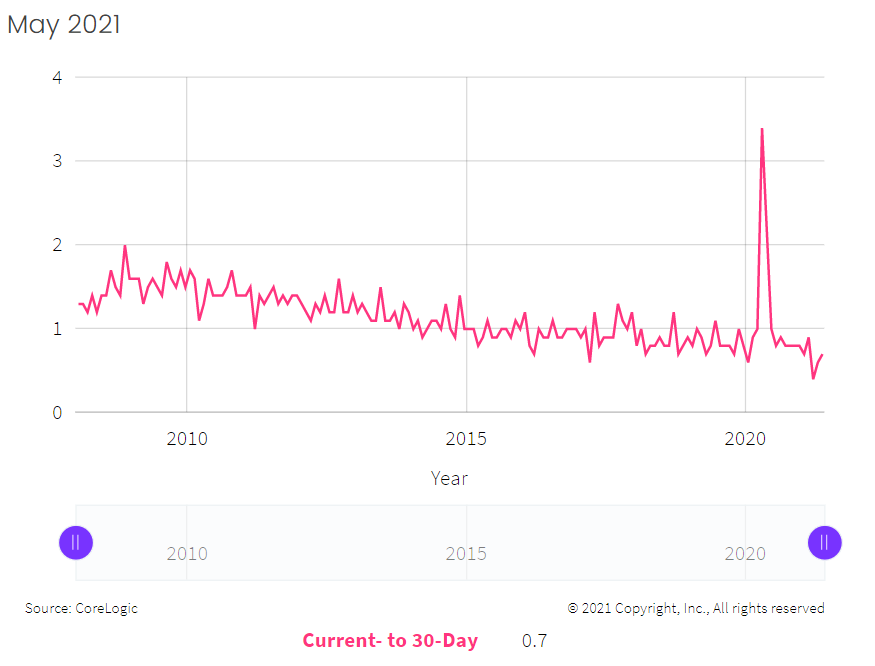
Loan Performance Insights Report Highlights: May 2021
In May 2021, 4.7% of home mortgages were in some stage of delinquency (30 days or more past due, including those in foreclosure), which was a 2.6-percentage point decrease from May 2020 according to the latest CoreLogic Loan Performance Insights Report. However, overall delinquencies were still above the early 2020 pre-pandemic rate of 3.5%.
Overall Delinquency Rates
The share of mortgages that were 30 to 59 days past due — considered early-stage delinquencies — was 1.2% in May 2021, down from 3% in May 2020. The share of mortgages 60 to 89 days past due was 0.3% in May 2021, down sharply from a post-pandemic high of 2.8% in May 2020.
The serious delinquency rate — defined as 90 days or more past due, including loans in foreclosure — was 3.2% in May, roughly two times that of a year earlier but down from a recent high of 4.3% in August 2020 and down to the lowest rate since the initial jump in serious delinquencies in June 2020. The CARES Act provides relief to mortgage holders and has worked to keep delinquencies from progressing to foreclosure and therefore the foreclosure inventory rate — the share of mortgages in some stage of the foreclosure process — remained low at 0.3% in May 2021, unchanged from May 2020. The decrease in the serious delinquency rate from the August high lessens the likelihood of a foreclosure wave later in the year when homeowners emerge from forbearance. In addition, the average homeowner in forbearance has a sizeable amount of equity in their home, which has helped create an additional financial buffer for those struggling to make mortgage payments.
Stage of Delinquency: Rate of Transition
In addition to delinquency rates, CoreLogic tracks the rate at which mortgages transition from one stage of delinquency to the next, such as going from current to 30 days past due (Figure 1).
**
Figure 1: Current- to 30-Day Transition Rate Shows Sharp Decrease From Year Ago**

The share of mortgages that transitioned from current to 30 days past due was 0.7% in May 2021 — a decrease from 2.2% in May 2020. Low transition rates indicate that while the rate of mortgages in any stage of delinquency remained elevated, fewer borrowers slipped into delinquency than during the recession.
Figure 2: States With the Highest and Lowest Rate of Mortgages At Least 30 Days Past Due

State and Metro Level Delinquencies
Figure 2 shows the states with the highest and lowest share of mortgages 30 days or more delinquent. In May 2021, that rate was highest in Louisiana at 7.9% and lowest in Idaho at 2.4%. All states posted annual decreases in their overall delinquency rates in May 2021 as the employment picture improved across the country compared to a year earlier.
Figure 3: Percentage of Mortgages At Least 30 Days Past Due For the Ten Largest Metropolitan Areas

Figure 3 shows the 30-plus-day past-due rate for May 2021 for 10 large metropolitan areas. Miami had the highest rate at 7.4%, and San Francisco had the lowest rate at 2.8%. Miami’s rate decreased 6.5 percentage points from a year earlier. Outside of the largest 10, all metros recorded a decrease in the overall delinquency rate. Nevertheless, elevated overall delinquency rates remain in some metros, including Texas (Odessa and Laredo), Arkansas (Pine Bluff) and New Jersey (Vineland).
Mortgage delinquencies fell from a year ago with the serious delinquency rate hitting its lowest level since June 2020. Continued improvements in the economy and job market this year will help borrowers remain current on their payments when the forbearance moratorium is lifted later this year, and large increases in home prices have given most borrowers in forbearance enough equity to pay their missed payments and still have some home equity remaining.
To learn more about the data behind this article and what CoreLogic has to offer, visit https://www.corelogic.com/.







Sign up to receive our stories in your inbox.
Data is changing the speed of business. Investors, Corporations, and Governments are buying new, differentiated data to gain visibility make better decisions. Don't fall behind. Let us help.













Sign up to receive our stories in your inbox.
Data is changing the speed of business. Investors, Corporations, and Governments are buying new, differentiated data to gain visibility make better decisions. Don't fall behind. Let us help.





